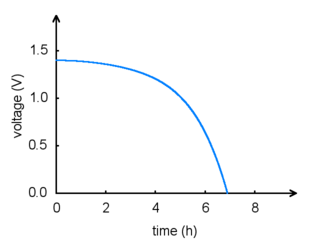これは Pololu 3pi Robot User’s Guide ≫ 5.a. Batteries の非公式日本語訳です。
目次
前: 5. How Your 3pi Works
次: 5.b. Power management
5.a. Batteries
Introduction to Batteries
バッテリ入門

Two rechargeable AAA Ni-MH batteries.
The power system on the 3pi begins with the batteries, so it is important to understand how your batteries work. A battery contains a carefully controlled chemical reaction that pulls electrons in from the positive (+) terminal and pushes them out of the negative (-) terminal. The most common type is the alkaline battery, which is based on a reaction between zinc and manganese through a potassium hydroxide solution. Once alkaline batteries are completely discharged, they cannot be reused. For the 3pi, we recommend rechargeable nickel-metal-hydride (NiMH) batteries, which can be recharged over and over. NiMH batteries are based on a different chemical reaction from alkaline batteries, but you don’t need to know anything about the chemical details to use a battery: everything you need to know about it is measured with a few simple numbers. The first is the strength with which the electrons are pushed, which we measure in volts (V), the units of electric potential. An NiMH battery has a voltage of about 1.2 V. To understand how much power you can get out of a battery, you also need to know how many electrons the battery can push per second – this is the electric current, measured in amps (A). A current of 1 A corresponds to about 6×1018 electrons flowing out one side and in to the other each second, which is such a huge number that it’s easier to talk about it just in terms of amps. 1 A is also a typical current that a medium-sized motor might use, and it’s a current that will put a significant strain on small (AAA) batteries.
3piの電源システムはバッテリから始まるため、バッテリの動作を理解することは重要です。バッテリは注意深く制御された化学反応を含み、正極(+)から電子を引き出し、負極(+)に電子を押し出します。最も一般的なタイプはアルカリ乾電池で、水酸化カリウム溶液を介した亜鉛とマンガンの反応に基づいています。アルカリ乾電池は完全に放電すると、再使用することができません。3piには繰り返し充電可能な充電式ニッケル水素電池(NiMH)を推奨します。ニッケル水素電池はアルカリ乾電池とは異なる化学反応に基づきますが、電池を使ううえでは化学の詳細について何も知る必要はありません。それについて知るために必要なすべては、簡単な数字で測ることができます。1つ目は電子が押し出される強さで、電位の単位のボルト(V)で測定します。ニッケル水素電池は約1.2Vの電圧を持ちます。電池からどれくらいの電力を取り出せるかを理解するためには、1秒間にバッテリがどれくらいの電子を押し出せるかを知ることも必要です。これは電流であり、アンペア(A)で測定します。1Aの電流は一方からもう一方に1秒間に流れる約6×1018の電子に相当します。これはとても大きな数字で、ただアンプの観点から電流についての説明をより簡単にします。1Aは中型モーターが消費する典型的な電流で、小型(単4)電池に大きな負担をかける電流です。
For any battery, if you attempt to draw more and more current, the voltage produced by the battery will drop, eventually dropping all the way to zero at the short circuit current: the current that flows if you connect one side directly to the other with a thick wire. (Don’t try this! The wire might overheat and melt, and the battery could explode.) The following graph shows a good model of how the voltage on a typical battery drops as the current goes up:
どんなバッテリでも、より大きな電流を引き出そうとすると、バッテリによって生成される電圧が下がり、短絡電流(太いワイヤで一方ともう一方を直接つなぐと流れる電流)でやがては0まで低下します。(これを試さないでください!ワイヤが過熱して溶けて、バッテリが爆発する恐れがあります。)次のグラフは、電流が増加するにつれて典型的なバッテリの電圧がどのように降下するかの良いモデルです。
The power put out by a battery is measured by multiplying the volts by the amps, giving a measurement in watts (W). For example, at the point marked in the graph, we have a voltage of 0.9 V and a current of 0.6 A, this means that the power output is 0.54 W. If you want more power, you need to add more batteries, and there are two ways to do it: parallel and series configurations. When batteries are connected in parallel, with all of their positive terminals tied together and all of their negative terminals tied together, the voltage stays the same, but the maximum current output is multiplied by the number of batteries. When they are connected in series, with the positive terminal of one connected to the negative terminal of the next, the maximum current stays the same while the voltage multiplies. Either way, the maximum power output will be multiplied by the number of batteries. Think about two people using two buckets to lift water from a lake to higher ground. If they stand next to each other (working in parallel), they will be able to lift the water to the same height as before, while delivering twice the amount of water. If one of them stands uphill from the other, they can work together (in series) to lift the water twice as high, but at the same rate as a single person.
バッテリが出力する電力は電圧に電流を掛けて、ワット(W)で測定されます。例えば、グラフのマークされた位置は0.9Vの電圧と0.6Aの電流であり、これは電力出力が0.54Wであることを意味します。さらに電力が必要な場合は電池を追加する必要があり、それには2つの方法(並列と直列)があります。複数のバッテリを並列に、すべての+端子同士と-端子同士をそれぞれ接続すると、電圧は同じままですが最大出力電流はバッテリの数で乗算されます。複数のバッテリを直列に、1つのバッテリの+端子を次のバッテリの-端子に接続すると、最大電流は同じままで電圧が乗算されます。いずれにしても、最大出力電力はバッテリの数で乗算されます。2人で2つのバケツを用いて湖から高台の陸地に水を汲むことを考えます。彼らが互いに隣り合って立っている(並列に働いている)場合、倍の量の水を以前と同じ高さまで運ぶことができます。1人がもう1人より高い場所に立っている場合、彼らは水を2倍の高さに運ぶために一緒に(直列に)働くことができますが、1人の時と同じ効率になります。
In practice, we only connect batteries in series. This is because different batteries will always have slightly different voltages, and if they are connected in parallel, the stronger battery will deliver current to the weaker battery, wasting power even when there is nothing else in the circuit. If we want more current, we can use bigger batteries: AAA, AA, C, and D batteries of the same type all have the same voltage, but they can put out very different amounts of current.
実際に、ただバッテリを直列につなぎます。これはつまり、1つ1つのバッテリは常にわずかに電圧が異なり、それらを並列につなぐと強いバッテリは弱いバッテリに電流を流し、回路に何もない場合でも電力を無駄遣いします。より大きな電流が欲しい場合は、大きなバッテリを使用するとよいです。同じ種類の単4、単3、単2、単1電池は同じ電圧を持ちますが、出力できる電流量が大きく異なります。
The total amount of energy in any battery is limited by the chemical reaction: once the chemicals are exhausted, the battery will stop producing power. This happens gradually: the voltage and current produced by a battery will steadily drop until the energy runs out, as shown in the graph below:
バッテリの総エネルギー量は化学反応によって制限されます。一度化学物質が消耗すると、バッテリは電力の生成を停止します。これは徐々に起こります。次のグラフに示すように、バッテリによって生成された電圧と電流はエネルギーが尽きるまで着々と低下します。
A rough measure of the amount of energy stored in a battery is given by its milliamp-hour (mAH) rating, which specifies how long the battery will last at a given discharge rate. The mAH rating is the discharge rate multiplied by how long the battery lasts: if you draw current at a rate of 200 mA (0.2 A), and the battery lasts for 3 hours, you would call it a 600 mAH battery. If you discharge the same battery at 600 mA, you would get about an hour of operation (however, battery capacity tends to decline with faster discharge rates, so you might only get 50 minutes).
バッテリに貯蔵されたエネルギー量のざっくりとした大きさは、既定の放電率でバッテリが持続する時間を定めたミリアンペア時(mAH)で表されます。定格mAHは放電率にバッテリの持続時間を掛けます。200mAのレートで電流を流したときにバッテリが3時間持続する場合、それは600mAHバッテリと呼びます。もし同じバッテリを600mAで放電すると約1時間動作します(が、放電率が速くなるとバッテリ容量が低下しがちになるため、50分しか得られないかもしれません)。
Note: If you have purchased rechargeable batteries for the 3pi, you should fully charge them before you first use them. You should never attempt to program your 3pi if its batteries are drained or uncharged. Losing power during programming could permanently disable your 3pi.
注意: 3pi用に充電式電池を購入した場合、初めて使用する前に完全に充電してください。消耗していたり充電してない電池では決して3piに書き込もうとしないでください。書き込み中に電源を喪失すると、3piは永久的に機能しなくなる可能性があります。

